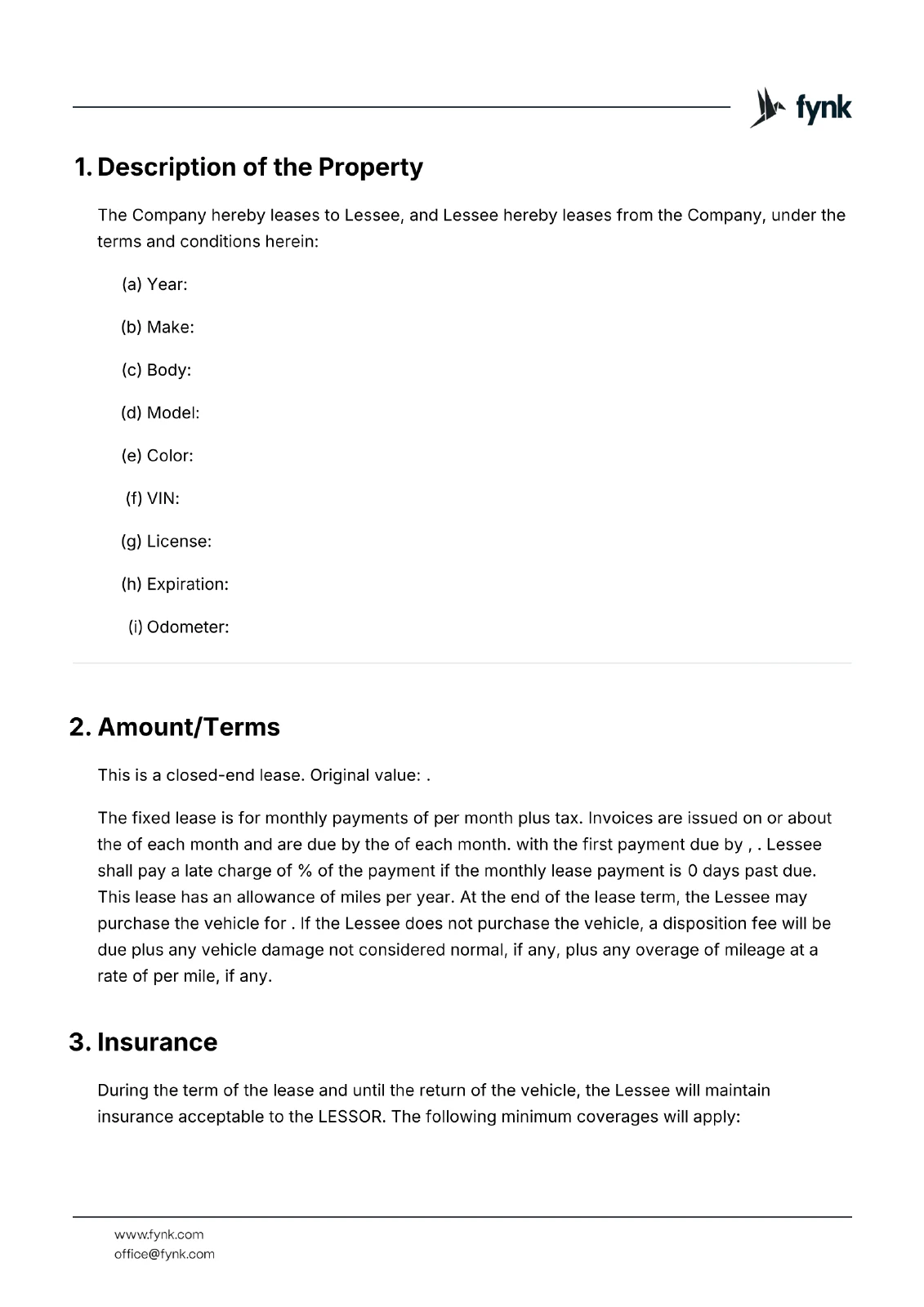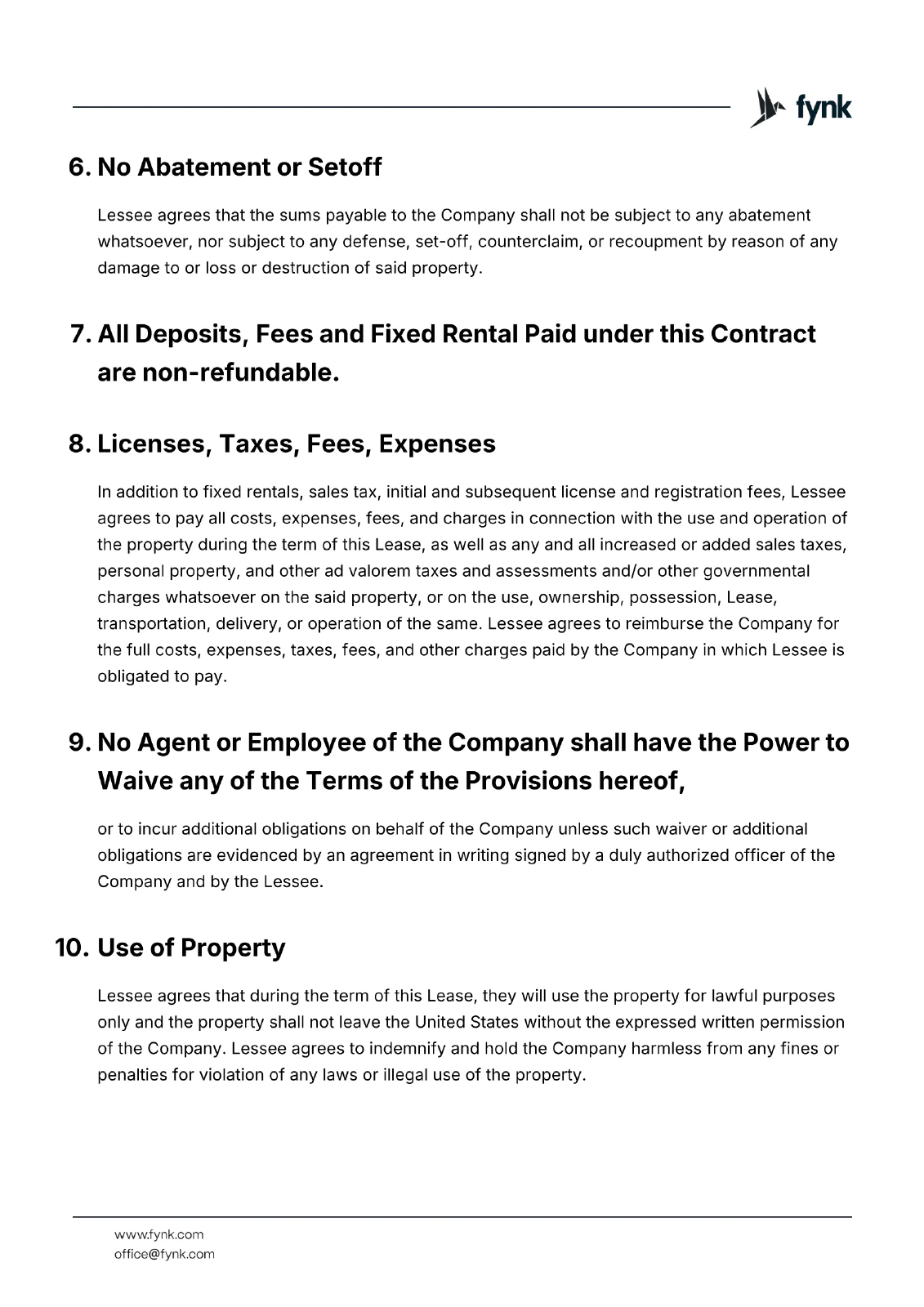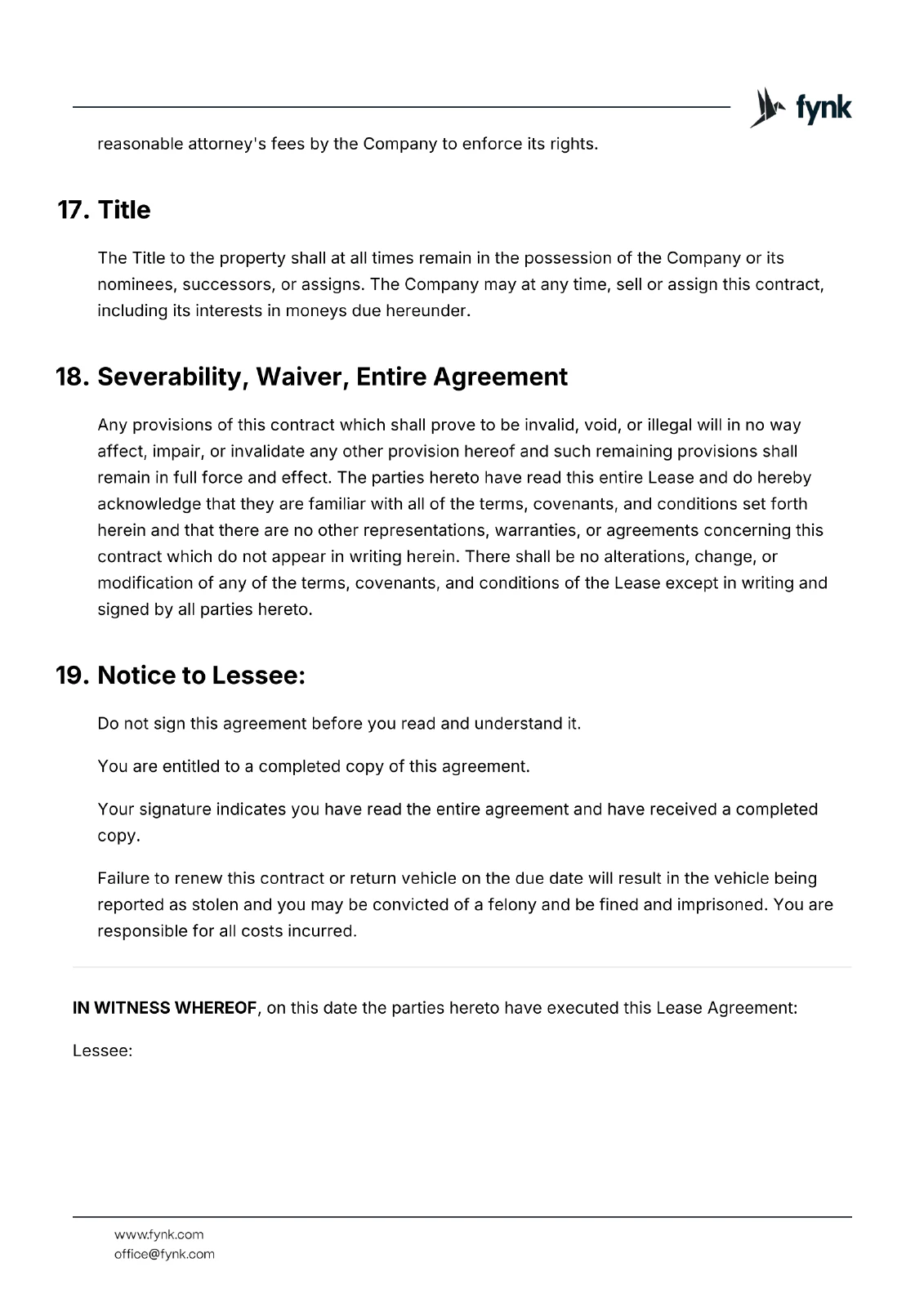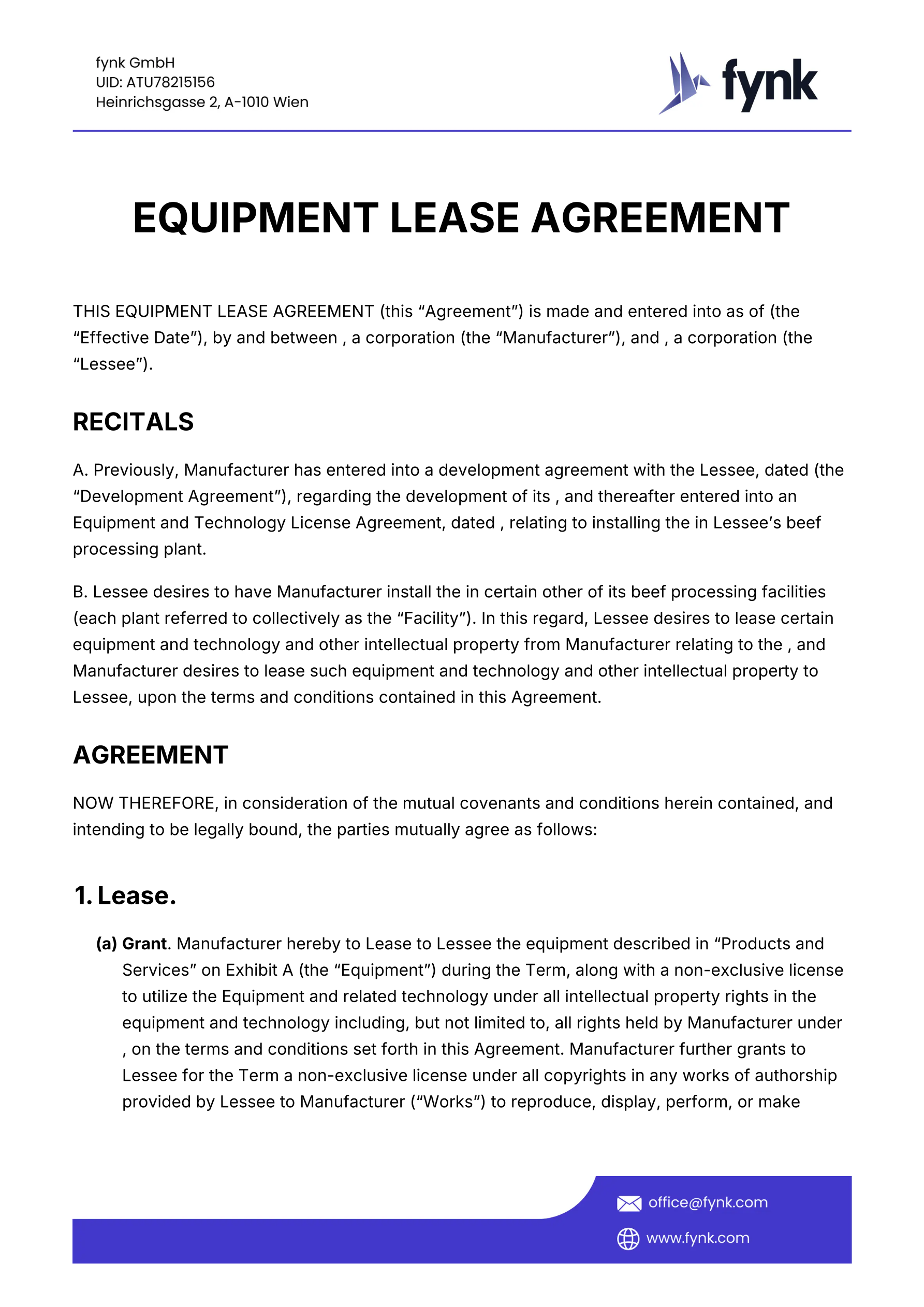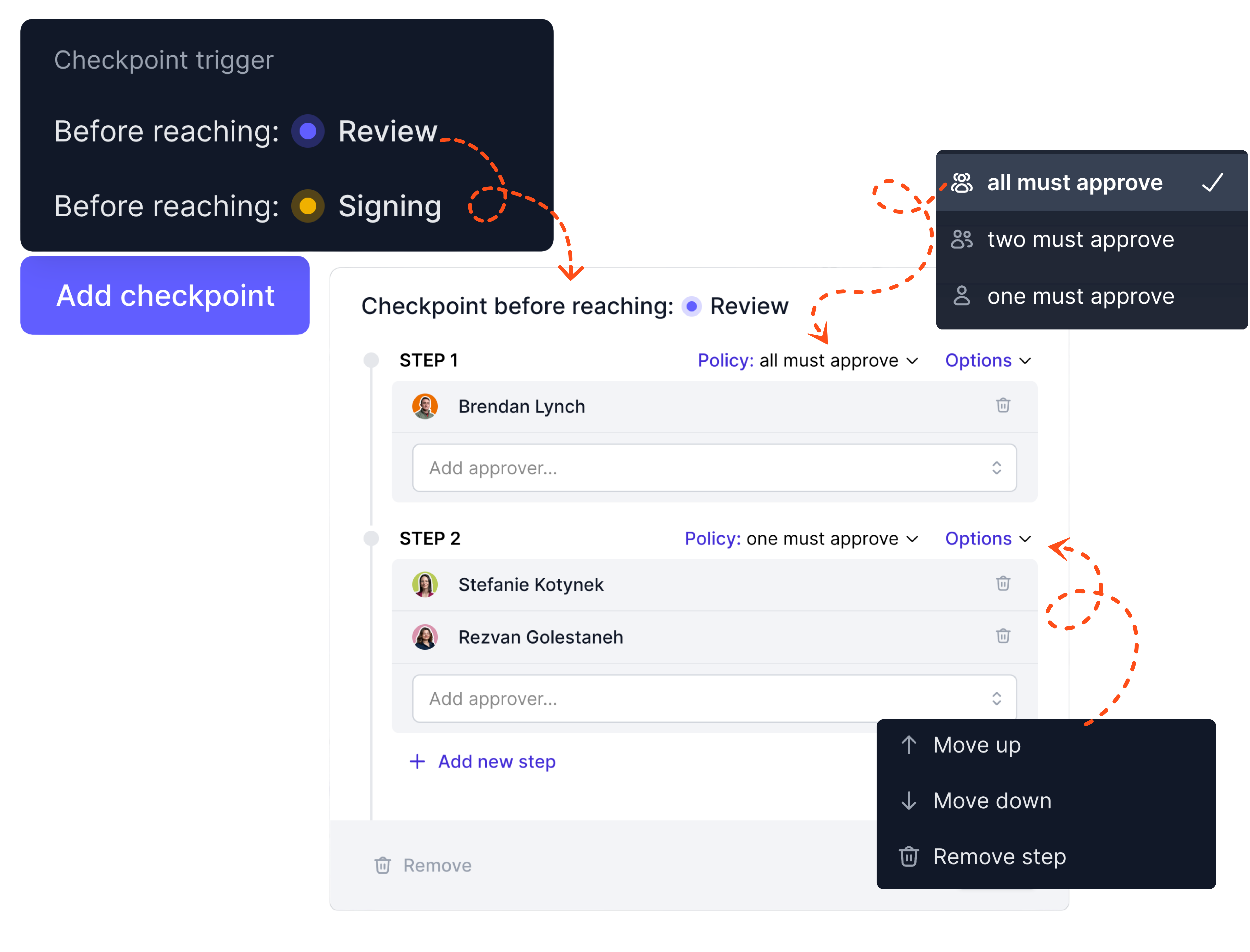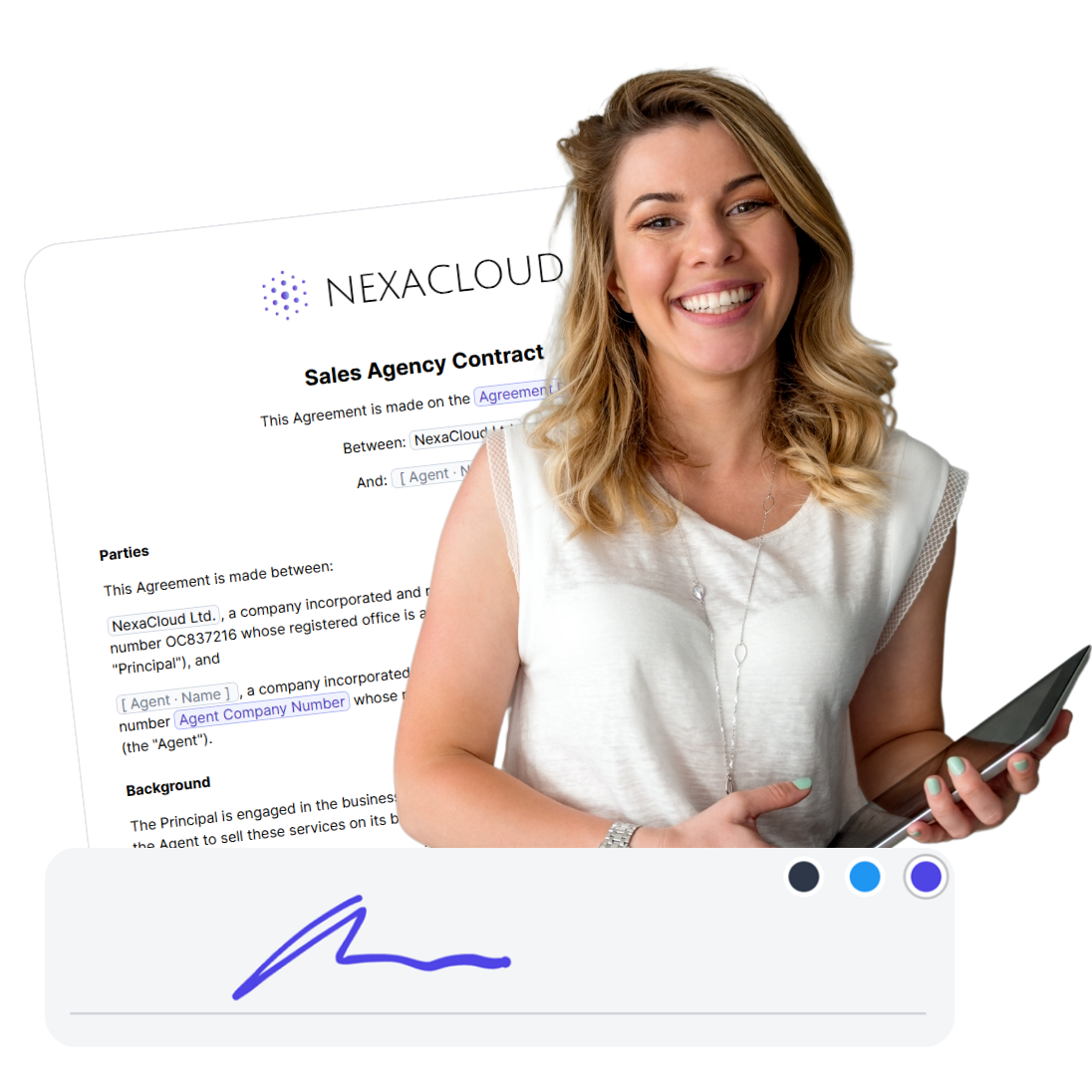Vehicle Lease Agreement
Today's Date:
Contract # :
This Lease Contract is entered into between: ("Lessee") and , hereinafter called "the Company", organized and operating under the laws of the State of .
The parties hereby mutually agree as follows:
Description of the Property
The Company hereby leases to Lessee, and Lessee hereby leases from the Company, under the terms and conditions herein:
Year:
Make:
Body:
Model:
Color:
VIN:
License:
Expiration:
Odometer:
Amount/Terms
This is a closed-end lease. Original value: .
The fixed lease is for monthly payments of per month plus tax. Invoices are issued on or about the of each month and are due by the of each month. with the first payment due by , . Lessee shall pay a late charge of % of the payment if the monthly lease payment is 0 days past due. This lease has an allowance of miles per year. At the end of the lease term, the Lessee may purchase the vehicle for . If the Lessee does not purchase the vehicle, a disposition fee will be due plus any vehicle damage not considered normal, if any, plus any overage of mileage at a rate of per mile, if any.
Insurance
During the term of the lease and until the return of the vehicle, the Lessee will maintain insurance acceptable to the LESSOR. The following minimum coverages will apply:
Comprehensive fire and theft coverage and collision coverage, each for actual cash value of the vehicle and with a maximum deductible of ; and
Liability insurance for at least:
per person and per occurrence for bodily injury or death; and
per occurrence for property damage.
The Lessee will list the Company as "Loss Payee" for the coverages in Section (3.a) and as "Additional Insured" for the coverages in Section (3.b). If the Lessee carries excess or umbrella liability insurance, it will include the Company's interest to the extent permitted by law.
The Lessee will give written proof of insurance coverage upon request. The Lessee will inform the Company at least 0 days in advance, in writing, if any term of insurance changes or the policy has been cancelled. If the Lessee fails to maintain the required insurance, or fail to provide you proof of insurance, they will be in default.
For claims arising under insurance that concern physical damage to the vehicle, the Lessee will appoint the LESSOR as their attorney-in-fact to initiate, settle, or release the claim. They may also sign any proofs of claim or loss on behalf of the Lessee, and receive and sign for the Lessee on any settlement, draft, or check. Lessee also gives a security interest in any money paid under my insurance.
Physical damage or liability insurance coverage for bodily injury or property damage caused by others is not included in this lease.
Damage, Destruction, or Loss of Vehicle
If, during the term of this Lease and until the return of the vehicle, it is damaged, destroyed, stolen, abandoned, or taken by any judicial or governmental authority, the Lessee will remain financially responsible. The Lessee shall notify the Company within 0 days of any of these events.
Setup Fee
There is a Setup Fee of which includes licensing, insurance verification, credit information, transportation, taxes, and other fees not necessarily fixed under this agreement.
No Abatement or Setoff
Lessee agrees that the sums payable to the Company shall not be subject to any abatement whatsoever, nor subject to any defense, set-off, counterclaim, or recoupment by reason of any damage to or loss or destruction of said property.
All Deposits, Fees and Fixed Rental Paid under this Contract are non-refundable.
Licenses, Taxes, Fees, Expenses
In addition to fixed rentals, sales tax, initial and subsequent license and registration fees, Lessee agrees to pay all costs, expenses, fees, and charges in connection with the use and operation of the property during the term of this Lease, as well as any and all increased or added sales taxes, personal property, and other ad valorem taxes and assessments and/or other governmental charges whatsoever on the said property, or on the use, ownership, possession, Lease, transportation, delivery, or operation of the same. Lessee agrees to reimburse the Company for the full costs, expenses, taxes, fees, and other charges paid by the Company in which Lessee is obligated to pay.
No Agent or Employee of the Company shall have the Power to Waive any of the Terms of the Provisions hereof,
or to incur additional obligations on behalf of the Company unless such waiver or additional obligations are evidenced by an agreement in writing signed by a duly authorized officer of the Company and by the Lessee.
Use of Property
Lessee agrees that during the term of this Lease, they will use the property for lawful purposes only and the property shall not leave the United States without the expressed written permission of the Company. Lessee agrees to indemnify and hold the Company harmless from any fines or penalties for violation of any laws or illegal use of the property.
Assignment/Subleasing
Lessee agrees that they will not assign, transfer, sublet, or in any way rent or lease his rights hereunder and will not lien or cause to be liened the property described herein.
Maintenance and Repairs
Lessee agrees to maintain the property in good working condition and not to misuse or abuse it.
Damage, Destruction or Theft
Lessee assumes the entire risk of loss or damage to the property from any cause whatsoever and the obligation of the Lessee shall not be affected in any manner irrespective of any damage, loss, or destruction thereof.
Indemnity
The Company shall not or under any circumstances be liable for any damage or injuries to persons or property suffered or sustained in the use, condition, or operation of the property and all such claims are specifically waived by Lessee. Company makes no warranties, expressed or implied, as to the condition of the property or its fitness for any particular purpose. Lessee agrees to and does hereby hold the Company, its agents and employees, free and harmless from any and all losses, costs, demands or liability of any kind whatsoever, including legal costs and attorney's fees. Upon demand, Lessee shall defend at Lessee's own expense, any claims brought against the Company.
Termination or Default
For any reason of termination of this contract, the Company shall have the right to take possession of the property and sell it to the highest bidder and the Company shall retain all proceeds.
Attorney’s Fees/ Legal Costs
In the event Lessee shall default hereunder, the Company shall be entitled to recover from Lessee, in addition to all other damages, all costs and expenses, including court costs and reasonable attorney's fees by the Company to enforce its rights.
Title
The Title to the property shall at all times remain in the possession of the Company or its nominees, successors, or assigns. The Company may at any time, sell or assign this contract, including its interests in moneys due hereunder.
Severability, Waiver, Entire Agreement
Any provisions of this contract which shall prove to be invalid, void, or illegal will in no way affect, impair, or invalidate any other provision hereof and such remaining provisions shall remain in full force and effect. The parties hereto have read this entire Lease and do hereby acknowledge that they are familiar with all of the terms, covenants, and conditions set forth herein and that there are no other representations, warranties, or agreements concerning this contract which do not appear in writing herein. There shall be no alterations, change, or modification of any of the terms, covenants, and conditions of the Lease except in writing and signed by all parties hereto.
Notice to Lessee:
Do not sign this agreement before you read and understand it.
You are entitled to a completed copy of this agreement.
Your signature indicates you have read the entire agreement and have received a completed copy.
Failure to renew this contract or return vehicle on the due date will result in the vehicle being reported as stolen and you may be convicted of a felony and be fined and imprisoned. You are responsible for all costs incurred.
IN WITNESS WHEREOF, on this date the parties hereto have executed this Lease Agreement:
Lessee:
Name:
Name:
Title:


